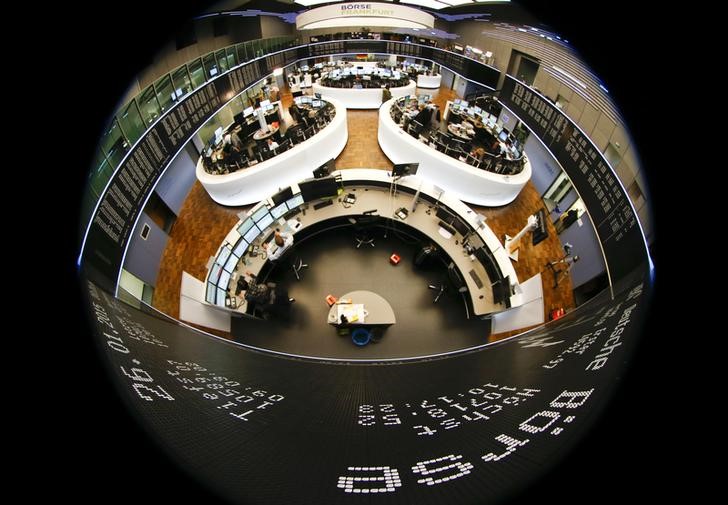* Oil rallies back above $30 a barrel after overnight drop
* European shares edge ahead after bumpy start
* Wall Street seen starting higher, Apple results in focus
* Jitters remain after China shares fall to 14-month low
* Hopes of dovish Fed, BOJ render some support
* Emerging markets bounce, rouble, lira, rand, peso gain
By Marc Jones
LONDON, Jan 26 (Reuters) - Markets went on another
rollercoaster ride on Tuesday as hopes that big oil producers
may start tightening supply drove crude oil prices higher and
pulled stocks out of a worldwide dive that included a
six-percent plunge in China.
European shares .FTEU3 were flat and Wall Street ESc1
was expected to start firmer with the focus on a flurry of data
and the first Federal Reserve meeting this year. ECONG7
After the torrid start to the year for markets, economists
are keen to see whether Fed policymakers will still be
signalling as many as four more rate hikes this year when they
emerge from their two-day meeting.
London .FTSE , Frankfurt .GDAXI and Paris .FCHI had
initially dropped as much as 1.8 percent after the slump in
China hit Japan, Hong Kong and the rest of Asia. .EU
The European fight-back from those levels was strongly
linked to oil's recovery from another bout of weakness to climb
back above $30 a barrel. O/R
Top OPEC and Russian oil industry officials stepped up vague
talk on Monday of possible joint action to remedy one of the
worst supply gluts in decades, though there were others,
including Kuwait, that say they doubt it will happen as long as
others are increasing their output.
"What seems to be behind this is the rebound in oil which
has turned around sentiment and we have seen that in equities
and Bunds (German government bonds)," Rabobank analyst, Bas Van
Geffen, said.
"There was some talk about a March OPEC meeting and if OPEC
is going to decide something on the supply side, that is going
to be supportive. But we don't yet know."
Brent and U.S. crude LCOc1 CLc1 were last up 1 percent
at $30.70 and $30.60 a barrel respectively, having dropped more
than 5 percent on Monday.
Other commodity prices including copper CMCU3 , iron ore
.IO62-CNI=SI and aluminium CMAL3 rose with it as did
oil-linked currencies such as the Russian rouble RUBUSD=R that
had started the day down more than 2 percent. FRAGILE CHINA
Markets were by no means in full recovery mode though.
Nervousness remained ahead of tech giant Apple's AAPL.O
results following recent noises from suppliers about a sharp
drop in iPhone demand.
Bond markets continued to draw in risk-averse investors
also. They were paying more than ever for ultra-safe 2-year
German government debt and yields on benchmark 10-year U.S.
treasuries held below 2 percent ahead of the Fed.
Asia's turbulent session saw mainland Chinese shares .SSEC
.CSI300 slump more than 6 percent to a 14-month low in another
sign that authorities in Beijing have their work cut out in
their efforts to stabilise fickle domestic markets.
There was more gloomy data, too, as China's annual rail
freight volume, viewed as a good temperature gauge of the giant
economy, fell 11.9 percent last year versus a drop of 3.9
percent in 2014.
The region's heavyweight indexes, Japan's Nikkei .N225 and
Hong Kong's Hang Seng Index .HSI fell 2.4 and 2.5 percent
respectively as the first two-day run of gains of the year came
to a shuddering halt.
"We are still slightly overweight China, but we are probably
going to go neutral," fund manager Hermes' head of emerging
markets equities, Gary Greenberg, said, citing a possible
further 10-percent yuan drop over the next year as one reason.
But as oil and stock markets steadied ahead of U.S. trading,
currencies began to turn as well.
The dollar shook off earlier pressure from the safe-haven
yen JPY= and the low-yielding euro EUR= while emerging
market players like the rouble RUB= , rand ZAR= , lira TRY=
and Mexican peso MXN= found their feet again.
Investors will be parsing the U.S central bank's post
meeting statement on Wednesday to determine what, if any, effect
volatile global markets, plummeting oil prices and heightened
fears of a Chinese slowdown have had on the Fed.
U.S. interest rate futures imply markets put the chance of a
Fed rate hike this week at just 13 percent. Over the year, they
are only expecting one rate hike now, compared to the Fed's
flagged rate path, which factors in at least four.
"There is a fair bit of nervousness going into the Fed
meeting. Interest rate markets have postponed rate hikes in 2016
and 2017 so investors expect something dovish from the Fed,
given the volatility in stock markets," Nordea strategist, Niels
Christensen, said.
